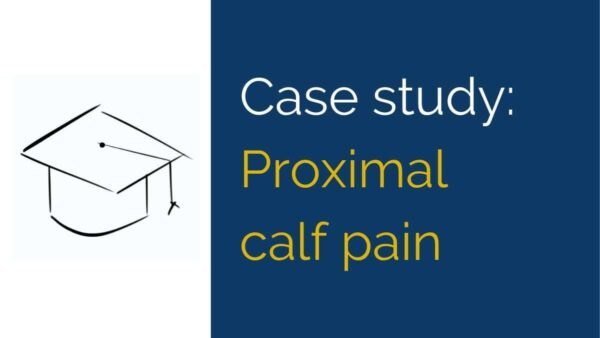Background – proximal calf pain
This case study presents a 6 week history of unilateral proximal calf pain in a 30 year old female. The case challenges diagnostic abilities and causative rationale.
Minimum level
This case study is suitable for new graduates through to experienced Physios.
History
Sally is a very active 30 year old lady who is noticed a recent onset of proximal calf pain in her Right leg.
The pain is difficult to place and seems diffuse in nature.
The proximal calf pain commenced after a treadmill run around 6 weeks ago. There was nothing remarkable about that particular session however it was Sally’s first week back to treadmill running in over 3 months (due to gym closures and COVID restrictions).
During the COVID lockdown period (~3 months), Sally switched from daily gym sessions, which always included a treadmill run, to running outdoors 4-5 times per week and daily walking.
On Sally’s return to the gym, she re-commence the same exercise program from before the lock down but used around half the set weight for each exercise.
Her treadmill runs were typically at 13-13.5km/h (4.30min/km) pace for 30 to 45 minutes.
During lockdown, Sally’s outdoor running was around the same pace for 25 to 40 minutes and always on flat ground.
Sally has been training at this level and this frequency for over 4 years now.
There was no recent changes to footwear and no new exercises on her return to the gym.
The proximal calf pain initially presented as an ache for a few hours after running.
Over the next 2 weeks the pain onset was typically mid run and would last for the remainder of the day.
At that time Sally was still able to train as normal but noticed the pain on plyometrics and calf exercises.
After resting for 3 days, the pain resolved completely and only returned slightly after a treadmill run.
Nominate your top 2 provisional diagnosis, including supporting information from the case so far.
Mentor’s reasoning:
Since then, the proximal calf pain has gradually worsened and it is now painful to walk for the remainder of the day after running.
The pain almost completely resolved after 2 days of rest while waiting on a scan (detailed below).
Sally has no past history of calf or lower leg injuries.
Sally describes her diet as very healthy and she also take supplements including magnesium and Vitamin C.
Does Sally’s comments about her diet alter your thinking on provisional diagnosis?
Mentor’s reasoning:
Imaging
After consulting her local doctor, Sally was referred for an ultrasound to confirm the diagnosis of a Right calf muscle strain.
The ultrasound reported a low level of fluid seen in and around the Soleus muscle but no discrete tear was noted.
Based on the imaging findings, have you adjusted your provisional diagnosis for Sally’s proximal calf pain?
Justify your answer.
Mentor’s reasoning:
The doctor advised Sally to return to running as symptoms would allow, however her next run lasted less than 200m before she had to stop due to significant pain.
Objective assessment
Calf circumference was 34 cm on Right, 33 cm on Left
What might account for this difference in calf circumference?
Mentor’s reasoning:
Quad circumference was symmetrical
Does this information change your thinking on the reasoning behind the difference in calf circumference?
Mentor’s reasoning:
Pain increased on single-leg stance and worsened on single-leg squat at 1/4 range
Does this fit with your provisional diagnosis?
Mentor’s reasoning:
Hip range of motion was symmetrical and normal
Ankle range of motion was symmetrical and above average
Explain how deficits in hip or ankle range may contribute to additional calf loading
Mentor’s reasoning:
There was moderate tenderness in a diffuse area over the proximal end of the medial head of Gastrocs, corresponding with Sally’s proximal calf pain description
Does this confirm or add support for a calf muscle strain?
Justify your answer.
Mentor’s reasoning:
There was severe tenderness on palpation on the medial border of tibia approximately 10 cm below the knee joint line
Name three pathologies that may present with severe tenderness in this location
Mentor’s reasoning:
There was no tenderness at the tibiofemoral joint line or on the Pes Anserine bursa
Diagnosis
Based on the case information to this point, provide a provisional diagnosis including nominating specific information that assisted you and why.
Mentor’s reasoning:
What is your theory on causative factors that may have led to this injury?
Mentor’s reasoning:
Further investigation
What test or imaging would you suggest to confirm the injury?
What is your rationale for selecting this option?
Mentor’s reasoning:
Would you suggest any additional testing specifically looking to identify causative factors?
Mentor’s reasoning:

